Fuji X-E2 Review
Ever since the X-E1’s released, it has been one of the most popular X Series cameras, and there are several significant reasons for this. It’s compact, it reminds us of simpler times in photography with its exceptional analog controls, it’s well built, and it produces stellar imagery. While it’s not a rangefinder, it does have many qualities of one, which many including myself, find extremely appealing. Best of all, the price is very reasonable. But like all cameras, the X-E1 is not perfect, and in order to fix some of these imperfections, the Fuji X-E2 was released.
Fuji X-E2 Build Quality:
Anyone who has owned an X-E1 will feel right at home with the Fuji X-E2 because it essentially inherited the X-E1’s compact size and great handling. The cameras look and feel almost identical. Like the X-E1, the X-E2 feels solid yet it’s still light weight, thanks to its die-cast magnesium body. This is a camera that is very easy to hold comfortably even if you need to do some one handed shooting. Best of all, the top deck features all of the great analog controls that many X Series users prefer.
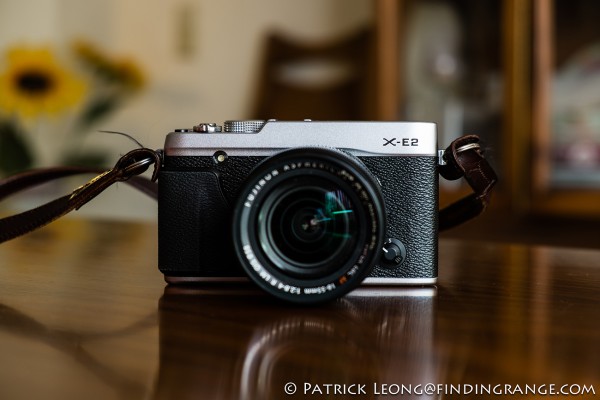
↑ Front view of the Fuji X-E2 with the XF 18-55mm.
However, there are some differences. For one, Wi-Fi has been added to the X-E2, so you can wirelessly transfer images from your camera to your phone. Face detection has also been added. In general, everything does feel slightly better built than the X-E1. For instance, the lens mount feels slightly tighter on my copy, and even the flash seems to pop out a little more delicately as if slightly padded. The exposure compensation dial has been slightly modified as well: now, it takes more torque to turn it, which helps prevent the dial from being moved accidentally. I’ve complained about accidentally moving the exposure compensation dial many times on past Fuji cameras but since I’ve had the X-E2, I have not had any issues. In addition, the exposure compensation dial range has now been expanded to ±3 instead of just ±2 on the X-E1.
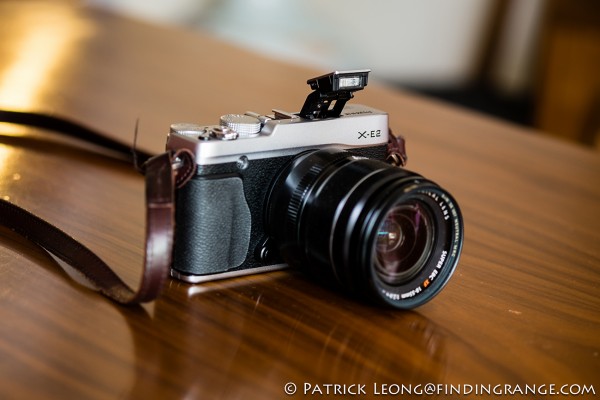
↑ The pop up flash can be really useful at times. It actually works quite well too.
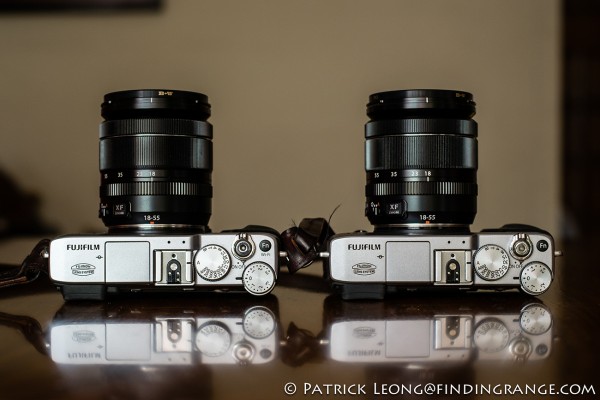
↑ The top plate of the X-E2 (left) vs. the X-E1’s (right).
Another welcomed change is the larger LCD screen. The X-E1 had a 2.8 inch, 460,000 pixel display with a 4:3 aspect ratio while the X-E2 has a 3 inch 1,040K-dot LCD monitor with a 3:2 aspect ratio. As you can see in the photo, the screen fills the back of the camera nicely. Everything still fits neatly in the back of the camera because all Fuji did was make the buttons on the left side of the camera a little smaller.
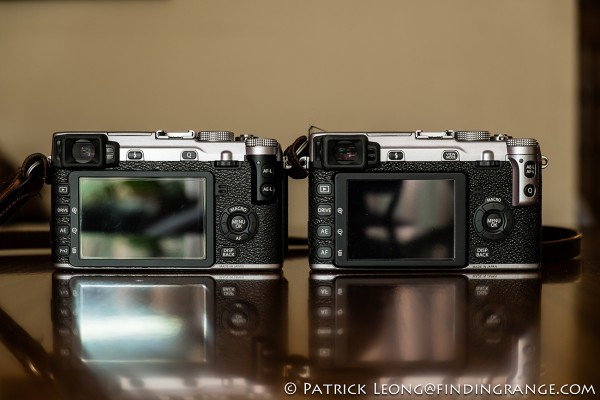
↑ The back of the X-E2 (left) vs. the X-E1’s (right).
For the most part, the screen is better, and hey, maybe some of you were okay with the original screen (I was) but you’re getting more for the same list price as the X-E1. The images are very clear, and there’s more detail. It’s definitely smoother than the one on the X-E1 as well. Since we’re on the topic of the LCD screen, I would like to mention that the EVF is also smoother on the X-E2 thanks to the faster refresh rate. They’re both much better, especially at night.
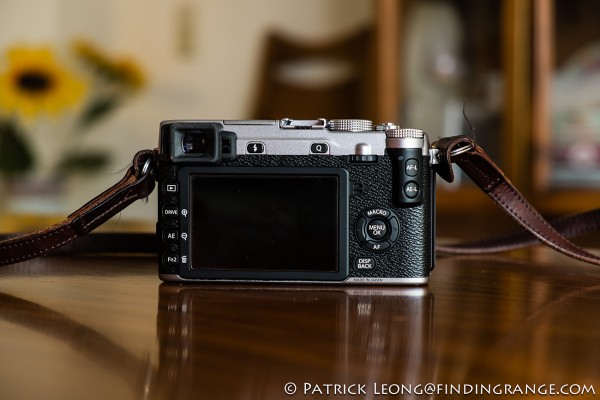
↑ Here’s another photo of the LCD screen.
I’ve used pretty much every single X Series camera and personally, the X-E1 was my favorite because to me, it has the best combination of attributes: it has all the analog controls of its larger brother, the X-Pro1 yet it’s more compact, and best of all, the image quality is excellent. I always liked the size of the X-E1 because it kind of reminds me of my Leica M3. In general, I prefer OVFs, so I’d rather have the X-Pro1’s hybrid viewfinder; however, for the price, I’m perfectly okay with just having an EVF. Overall, the Fuji X-E2 is a camera with more evolutionary changes rather than revolutionary changes, which is fine by me because I absolutely loved using my X-E1. I thought it was an excellent camera. I still do. I didn’t think much needed to be changed, and I am very glad that Fuji kept a lot of it the same.
The Image Quality From The Fuji X-E2:
Now, let’s talk about image quality in more detail, since this is where I think the Fuji X Series really shines. With its updated 16.3MP APS-C X-Trans CMOS II sensor, the X-E2 produces absolutely superb image quality. There are a lot of great cameras out there nowadays but I just love the results that I get from the Fuji X Series. It can be quite addicting, especially for the price. Images are very clean, sharp, and contrasty. Photos have a nice three dimensional pop to them, and the dynamic range is excellent. I like shooting in Raw but if you prefer to shoot in jpeg, the X-E2 is definitely a great camera to buy, since the out of camera jpegs are brilliant.
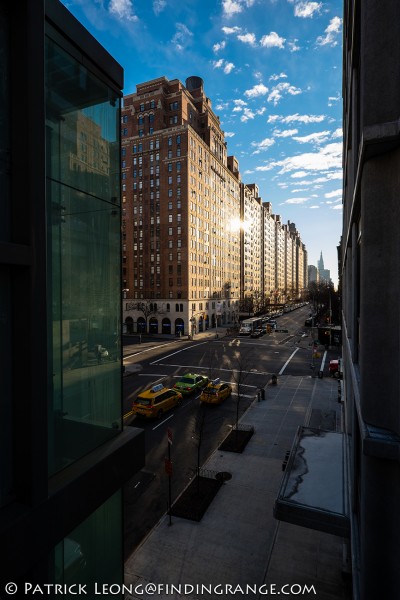
↑ Photos look three dimensional coming out of the X-E2; there’s a nice clarity to them as well. This was taken with the Zeiss Touit 12mm F2.8 early in the morning.
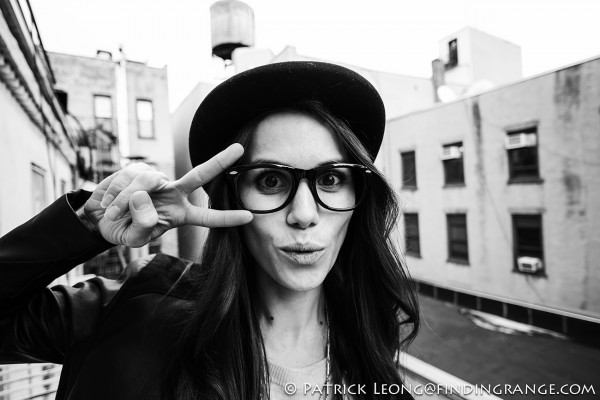
↑ Here’s another photo taken with my Zeiss Touit 12mm.
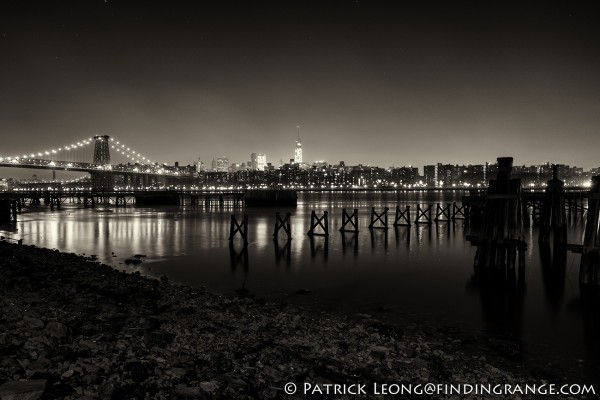
↑ Here’s photo taken with the XF 18-55mm at 200 ISO on a tripod.
Overall, images from the Fuji X-E2 are better than what I get from the X-E1, but like I said before, the upgrades in the X-E2 are not major in my eyes. Image quality is better coming from the X-E2 but in my opinion, not significantly. But in a way, that kind of makes sense; The X-E1 was and still is a great camera; we also have to remember that the X-E1 is only a year old. Technology moves fast nowadays but in my opinion, not that fast :). I don’t argue that there isn’t any improvement over the X-E1; I just don’t believe the tech in the X-E2 is a huge improvement over the X-E1. What you’re paying for is a camera that is more well-rounded, and refined rather than completely redesigned.

↑ This photo was taken with the Leica 35 Summicron ASPH.
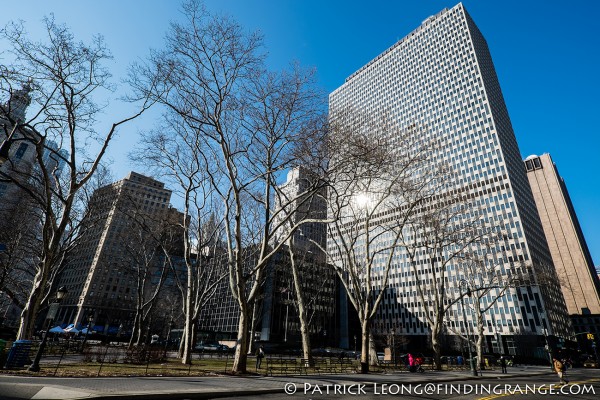
↑ Here’s a photo taken with my Zeiss Touit 12mm F2.8. There’s really nice “pop” from the X-E2.
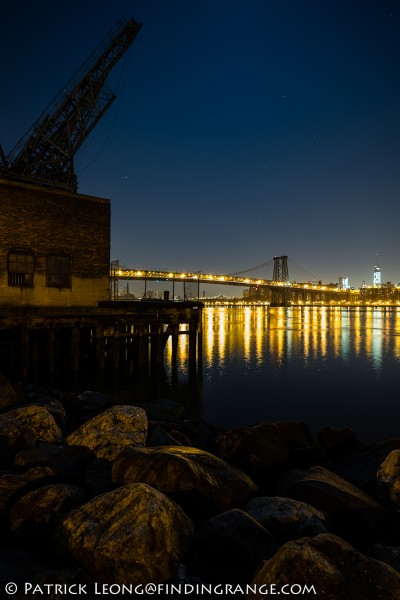
↑ Here’s a shot taken with one of my favorites, the Zeiss Touit 12mm F2.8, at 200 ISO on a tripod. It was such a cold night! The windchill was in the negatives!
The High ISO Capabilities of the Fuji X-E2:
The image quality doesn’t just stop when you’re shooting in the higher ISO range. Like the rest of the X Series line, the Fuji X-E2 has excellent high ISO capabilities. I don’t have any reservations with using slower lenses at night because I know I can produce clean images at higher ISOs. Images are great all the way up to 3200 ISO, and 6400 is good as well, depending on what you’re shooting. However, there is no RAW support for 100 ISO, and anything higher than 6400 ISO. Here are just a few examples of 3200 ISO or higher. These were all taken with the Zeiss Touit 12mm F2.8:
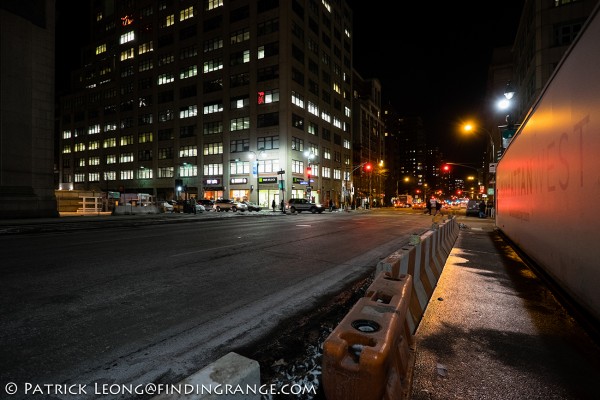
↑ 3200 ISO.

↑ 3200 ISO.

↑ 3200 ISO.

↑ 6400 ISO.
The Fuji X-E2 Autofocus:
There are definitely cameras out there that have faster autofocus than the Fuji X-E2 but that doesn’t matter to me because the autofocus has definitely improved, it is faster than the X-E1, and it works great for me. I never really have that feeling that I need more from it. Is it as fast as a camera like the OM-D? Maybe not but it is definitely fast enough, and that’s what’s important. The autofocus never frustrates me. For instance, the XF 60mm is one of the slower lenses that Fuji makes but it actually works quite well with the X-E2. Overall, the X-E2 also has no problem locking on subjects even in less than ideal lighting conditions.
How does it compare with the X-E1? Well, there have definitely been a lot of great firmware updates for all the Fuji cameras, and because of this, the X-E1 has definitely come a long way since its release. I really believe the autofocus on the X-E1 is actually quite good now. However, there is a noticeable improvement in the X-E2’s autofocus over the X-E1, and you really feel this once you’re outside and actually shooting with it. What you’re getting over the X-E1 is a little more confidence, and at times, that can go a long way.
Manual Focusing With The Fuji X-E2:
Manually focusing with the Fuji X-E2 is quick, easy, and actually quite enjoyable. I love using my M mount lenses on it, and while Fuji does makes great lenses, it’s good to be able to expand my lens collection by using my M lenses as well. Plus, it’s a great way to try out new focal lengths that Fuji does not make for the X Series.
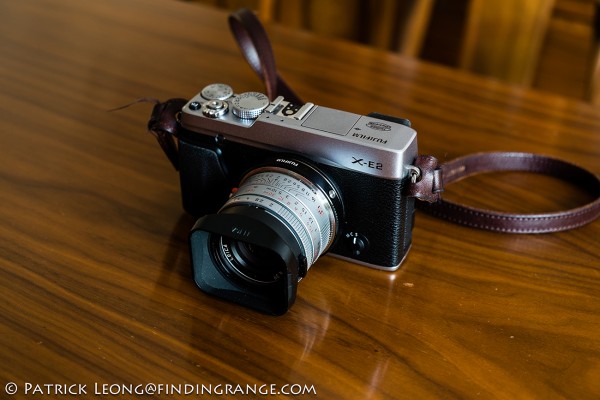
↑ The X-E2 with the Fuji M Adapter and Leica 35 Summicron ASPH. There are plenty of lenses from Leica, Zeiss and Voigtlander that you can try on the X-E2 with the M adapter. I will definitely be exploring more with manual lenses in the future.
There are two ways to focus manually:
- Digital Split Image: By aligning the split image, you’re able to focus the image with greater ease than without it.
- Focus Peak Highlight: This function highlights high contrast areas of your subject to help focus it with greater accuracy. The focus peaking is also adjustable in the menu, so you’re able to increase the intensity of the highlighting to see it more clearly.
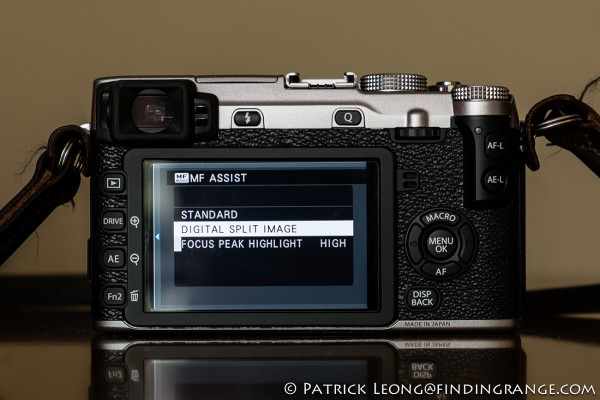
↑ Digital Split Image MF Assist.
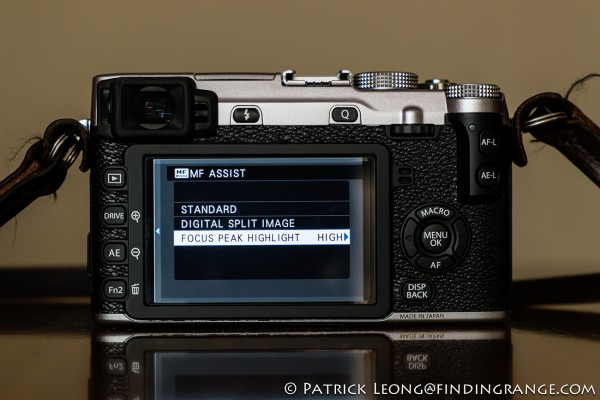
↑ Focus Peak Highlight MF Assist.
Digital Split Image vs. Focus Peak Highlight:
Personally, I prefer the focus peaking over the digital split image. I think Fuji really tried to make the digital split screen affective, and maybe it works well for others but I find it rather difficult to see the split image on a digital screen. The focus peaking works better for me. I’ve been experimenting with my M lenses, and I love the results. The ability to increase the intensity of the focus peaking makes it a lot easier to manually focus quickly and accurately. Of course, thanks to a new firmware update, the X-E1 also has the ability to to increase the intensity of its focus peaking as well.
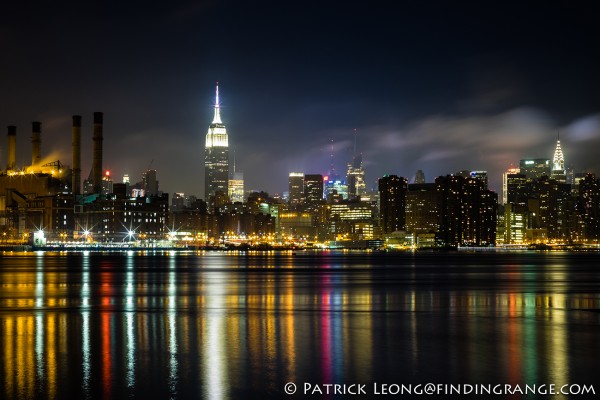
↑ This was taken with Leica 50 Summicron. I used an older version with the detachable hood, and it can sometimes be found on the used market for a decent price. It’s great on the Fuji because it essentially gives me a 75mm equivalent F2.0 lens that’s less than 2 inches long! If interested, give Bob at Bergen County Camera a call; he often gets a couple of copies in excellent condition.
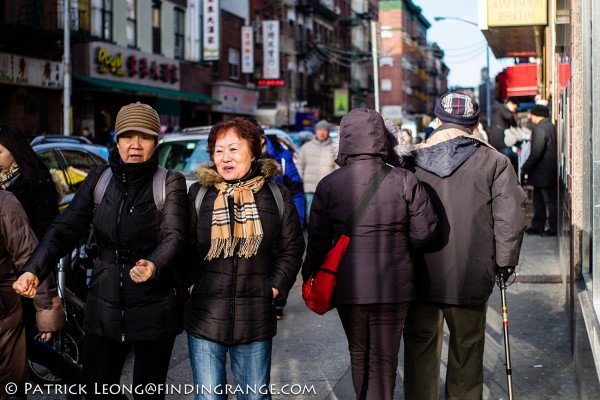
↑ This was taken with my Leica 35 Summicron ASPH.
Fuji X-E2 vs. Fuji X-E1:
There is no doubt in my mind that the Fuji X-E2 is a better camera than the X-E1. There are a lot of features and improvements that the X-E2 has over the X-E1 but the main ones that come to my mind are:
- Faster autofocus.
- Better image quality.
- Overall functions feel faster; camera feels more well-rounded and confident.
- EVF and LCD screen runs smoother thanks to faster refresh rates.
- Bigger and better LCD monitor.
- Tighter exposure compensation dial.
- Wireless ability.
So, what does this mean, exactly? Should you replace your X-E1 with the new X-E2? Well, for those who wanted some of the features mentioned above, it might be worth it to you. The X-E2 is everything the X-E1 is but better, and the truth is, some of the points that I’ve mentioned can not be solved with firmware updates.
However, if you’re happy with your X-E1, stick with it. You might even find it more worthwhile to invest in a lens instead. As I said before, the changes made in the X-E2 are not revolutionary changes. In my eyes, the X-E2 is Fuji’s attempt to refine the X-E1, which is already a great camera. In my opinion, while the new features and refinements are definitely welcomed because they make the X-E2 a much more well-rounded camera than the X-E1, I feel that Fuji could’ve waited maybe another year or even longer before releasing the X-E2. Then, I believe, we would see more significant changes. I think companies are coming out with too many cameras at to fast a pace these days, but that’s just my opinion.
For a while, I wasn’t really sure if I was going to purchase the Fuji X-E2. I was kind of getting in the groove with my X-E1, and with the recent firmware updates, the autofocus is A LOT better than what it was when the camera was first released (Fuji is awesome with firmware updates!). Yes, image quality from the X-E2 is better but I don’t think it’s significantly better.
With the rest of the improvements that I’ve mentioned, I can live with a slower refresh rate and the smaller screen. The truth is, the slower refresh rate didn’t bother me, and while I chimp occasionally like everyone else, I usually take a closer look at my images when I’m at home with my computer. The tighter exposure compensation dial is a nice touch but not a huge deciding factor for me, and I won’t be using the wireless ability in my X-E2. What ended up pushing me to buy the X-E2 was my friend’s offer to purchase my X-E1 without me even asking him (he knew I was looking at the X-E2). It was an easy sale, and I also sold a lens before that, which I was not using anymore, so I figured I’d give the X-E2 a try.
But if you’re new to the X Series system, I wholeheartedly recommend the Fuji X-E2. It is a fantastic camera, especially for the price. I absolutely love the image quality from the whole X Series line, and the fact that the X-E2 has essentially an updated version of the 16.3MP X-Trans sensor found in the X-E1 makes it even better. Combine the excellent image quality with the great analog controls of the X-E2, and you have a superb camera that not only takes great photos but also brings back the fun in photography. The X-E2 has all the hallmarks that make the X-E1 such a great camera but it’s more well-rounded and confident. For the price, the X-E2 is near perfect for me.
Fuji X-E2 Pros and Cons:
Fuji X-E2 Pros:
- The same great feel of the X-E1 but with faster electronics.
- Analog controls and in many ways, rangefinder feel.
- More torque is required to turn the exposure compensation dial.
- Compact and well built.
- Great LCD screen.
- Fantastic image quality.
- Great High ISO capabilities.
- Autofocus is decent.
- The X-E2 works great with manual lenses.
- A polished and refined version of the X-E1, which is already a great camera.
- An improvement over the X-E1 yet also the same list price.
Fuji X-E2 Cons:
- While definitely an improvement over the X-E1, it’s not a game changer.
- Screen Mode button disappeared.
- Tripod mount is next to the battery making it difficult to swap your battery or SD card.
- Some may want a tilting LCD screen.
Fuji X-E2 Verdict:
The Fuji X-E2 is a fantastic camera, and it addresses many of the issues that people had with the X-E1. Fuji did not mess with with the main formula of the X-E1, which made it such a spectacular camera; instead of making major changes to the basic X-E design, which was loved by many, Fuji chose to polish and refine the design.
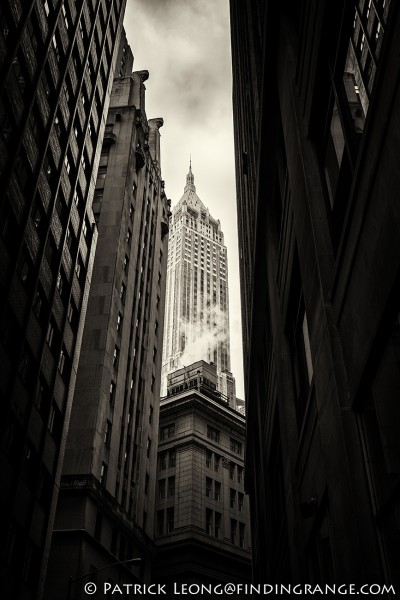
↑ I shot this with the XF 18-55mm.
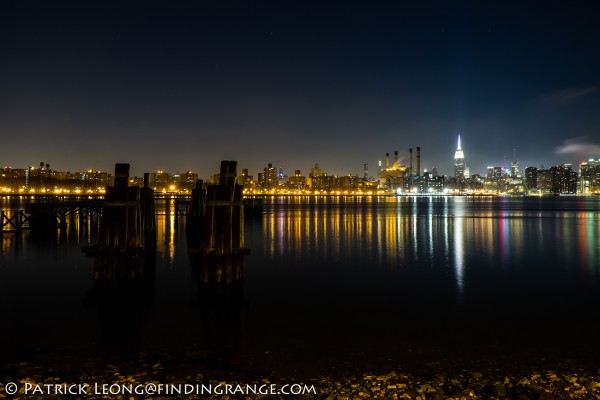
↑ Here is another shot taken with the XF 18-55mm.
The essence of what made the X-E1 such a great camera is still clearly evident in the new X-E2: the excellent handling, its compact size, and superb image quality. Every time I pick up my X-E2, I still experience that delightful analog feel that is so evident in all of the X Series cameras. This camera is not about having an abundance of electronics; it’s a camera that gives the photographer back the control that seems to be lost in a lot of cameras these days.

↑ Here’s one more shot taken with the XF 18-55mm.
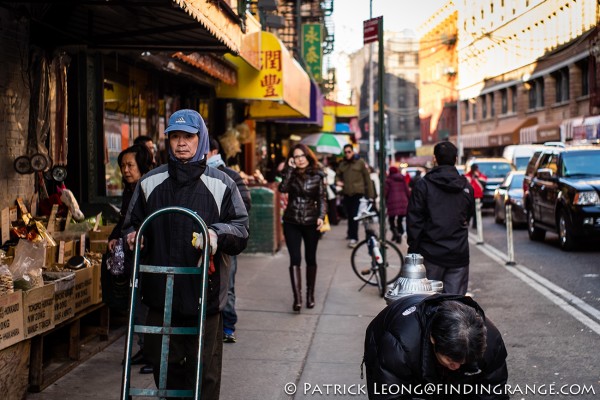
↑ I took this with my Leica 35 Summicron ASPH.
The Fuji X-E2 brings its user back to the basics of photography, which is why I love the X Series so much. It thoroughly involves the person in the photographic process, which is also what makes this camera so plain out fun to use. It makes you want to go out and shoot. It makes you want to learn more. The X-E2 is very versatile; it can be a great camera to take on vacation with the family but at the same time, it won’t limit your creative potential. It’s a camera that will really allow you to grow as a photographer. These were the important factors to me that made the X-E1 such a successful camera, and now they are more easily accessible thanks to tweaks and small changes, which brings the X-E series of bodies even closer to a state of completeness.
That’s it for this review, I hoped that you all thoroughly enjoyed it. Thanks for stopping by!
If you’re considering buying the X-E2, and my review helped you decide, please help support me by purchasing from one of the links below. Thank you for your support!
Amazon: Fuji X-E2 Body or Fuji X-E2 Kit
Adorama: Fuji X-E2 Body or Fuji X-E2 Kit
Contact Bob at Bergen County Camera

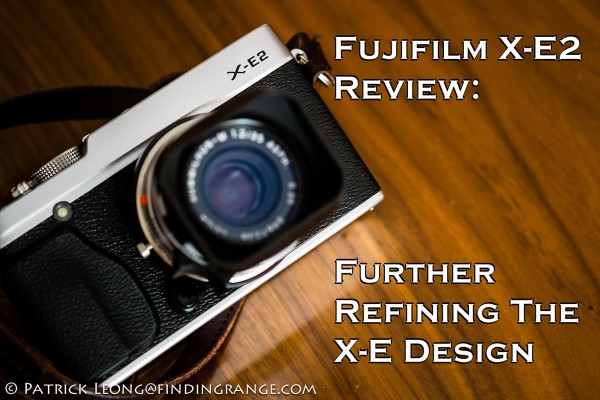
Thank you, Patrick, for this look at the advantages of the X-E2 over the X-E1.
Regarding image quality: I’m using the X-E1 as my travel camera and don’t really see any improvement, however slight, in image quality. Take a look at the images in the Mexico galleries on my website to see if you concur.
All images included in Guanajuato, Mexico and Guanajuato in Black and White were captured with the X-E1. The shots from Portland, Oregon were also taken with the X-E1.
Hi Nicolo,
Thanks for leaving a comment and for taking the time out to read my review! You have some really first class shots there! Thanks for sharing them with me. The advantages that the X-E2 has over the X-E1 are small, and I urged anyone who is happy with their X-E1 to keep it. It’s a great camera, especially with the updated firmware.
All the best!
Patrick
Hi Patrick,
Nice write up the X-E2. I love my X-E1, but have been thinking of upgrading to the X-E2, or the soon to be released, X-T1. Nice work, thank you for sharing, and I love your beautiful images.
Alan
Hi Alan,
Thanks and it’s great to hear from you! The X-T1 looks great but I don’t know, I’ve always been a big fan of the X-E series. But if you’re happy with your X-E1, it might even be worth it to just keep it. For some reason, I have this strange loyalty to the X-E1 even though I bought the X-E2. It’s probably my favorite Fuji camera. The firmware updates that Fuji keeps coming out with make it a really solid camera. I sold my X-E1 to my friend, and he’s having a blast with it :). He’s always trying to get me to go out with him to take pics.
Take care!
Patrick
Hi Patrick,
good to hear that you enjoy the E2. I like the night shots best. Crisp and nice color. Very impressive. I already liked my E1 and maybe i jump into the X series one more time. I was caught by surprise when Fuji announced the X-T1. I think this is a very interesting camera as well. I am also very exited about the announcement of a new super telephoto lens. This should be great for all wildlife photographers. Fuji is doing a fantastic job on lenses. Something that adds to the quality of their bodies.
Thank you for your well written review/comparison. Take care.
Hi Elderin,
It’s great to hear from you, and thanks for checking out my photos! I always appreciate you taking the time out to read my reviews. The telephoto sounds great…the 56mm, right? I definitely want to get a copy in to try out. I’ve actually been experimenting with a Leica 75 Summarit on the Fuji, and it seems to be an awesome combo. I’ve never used the 75 Summarit before but it’s a pretty incredible lens. I’ll post some stuff with it on the X-E2 here soon. Sorry for the late reply. I’ve had some back ache…a pinched nerve. Hope to hear from you soon!
Take care!
Patrick
Hello Patrick,
As an X-E2 owner, I totally agree with all the good things you have to say about it, but also share your concerns about Fuji’s decisions to introduce new cameras seemingly before the actual improvements would justify or require. The new X-T1 seems to be another case in point (unless maybe their goal here was to offer an SLR type camera primarily for the US & Europe where SLR sales still dominate the markets). Also really appreciated both the discussion & images showing how well M mount lenses can be used on the X-E2. But sorry you had to get out in such bad weather to capture your excellent photos. Will look forward to your further blogs about using adaptive lenses on the Fuji’s. Cheers,
Jed
Hi Jed,
It’s always great to hear from you! Believe it or not, I hurt my back AGAIN! A different part this time…uhh…thanks for taking the time out to read my review. I wanted to add more photos but didn’t get a chance, so I’ll probably add more soon. In regards to the X-T1, who knows what Fuji is doing. Maybe they’re trying to capture some of the OM-D users :). In terms of M lenses, I’ve been shooting with that 75 Summarit I told you about, and it works absolutely great on the Fuji. I’ve never used the 75 Summarit before but I’m quite pleasantly surprised (in the M 240 and the X-E2). I’ll definitely post some photos up when I’m finished processing them. Thanks for always visiting!
All the best!
Patrick
Hi Patrick,
Great review and comparison between the XE1 and XE2. You hit all of the points for the XE2 and I agree with your statements. Especially for the AF speed. I was able to try the new XT1 this weekend at our local Photo and Camera fair and I felt that the AF speed was about the same as the XE2. Anyway, I’m sure you will also be doing a review on that one as well.
Great to see you getting to use your Leica glass on the XE2. I really like the images coming from the 35mm Cron Asph.
Cheers,
Kerwin
Hey Kerwin!
Thanks for checking out my review! The Summicron works great with the Fuji, especially since it’s so small. That’s great that you got to play with the XT1. How do you like it? Remember that 75 Summarit I borrowed from Bergen County Camera? It works great on the Fuji. I’ll email you with details…sorry for the late reply! I had two pinched nerves in the last couple of weeks, so now I’m playing catch up :).
All the best!
Patrick
As usual,your photo toning were great and awesome 🙂 I am sure u enjoy it alot.For manual lens topic, i am usual some vintage lens as i previously told u and is working great, do check out my blog to see it,ahaha..nut i would hope for bigger view finder and different colour peaking
Great day ahead 🙂
Hi Meng,
Thanks! Yes, I remember our discussion about those vintage lenses you were using. I would definitely like to try out some vintage lenses in the future. I checked out your photos, and as always, they look great! You brought up great points; it would be nice to maybe be able to select a color like red for the focus peaking.
All the best!
Patrick
Hi Patrick!
Many thanks for your review! I have almost gave up waiting for it…but now very happy to read!
You have written that X-E1 is very popular in USA. I come from Czech Republic in Europe and here situation is different. DSLRs are much more popular here even among point-and-shoot photographers! 😀
I really love my X-E1 and don`t miss my bulky Nikon D7000 anymore. You are right, Fuji X cameras are much more about joy and that process of creating photos.
Btw. I have to say that photos You`ve made with Zeiss 12mm are really great!!
Regards, Jiri
Hi Jiri,
Thanks for taking the time out to read it! Sorry for the lateness, I hurt my back…I had a pinched nerve. It was hard to get out there and take pics. I’m feeling a lot better now, so expect some more posts!
I love the X Series cameras, and it’s unfortunate that they are not as popular in the Czech Republic. I went on vacation to Disney and I didn’t see any X Series cameras there but there were definitely people who were interested in my X-E1. It seems a lot of people still haven’t seen these cameras yet.
Thanks for the kind words regarding my photos taken with the Zeiss! The Zeiss is actually one of my used lenses…I love it. Anyway, I will definitely be posting more in the coming weeks. I always appreciate you visiting!
Take care!
Patrick
Hey Patrick,
although that fast portrait lens that you mentioned should be also very interesting i was referring to a fast super telephoto that should be available end of this year (hopefully). My guessing is a lens in the 300-400mm range and an aperture of f4.
Hi Elderin,
Sorry for the late reply. It will definitely be great to have a super fast telephoto in the X Series system. It should definitely make the X Series a lot more versatile.
Take care!
Patrick
Hi Patrick,
Thanks for your review of the X-E2 and comparing it with the X-E2. I am new to the X-series and bought the X-E2. In many reviews I read about the great image quality. One thing I miss in all those reviews is the information about the film simulation modes used when shooting the photos. I would like to find out which film simulation mode gives that great results. For example, I love this photo of yours: Fuji-X-E2-Zeiss-Touit-12mm-F2.8-High-Line-New-York-City-1. Would you tell me please which film simulation mode you used with this one?
Volker
Hi Volker,
Sorry for the late reply, and thanks for taking the time out to read my review! I set my X-E2 to shoot both Raw and jpeg mode. The jpeg simulation mode that I usually choose is Velvia mode. I used to shoot a lot of Velvia back in the film days, and I just love the vibrant colors that this mode produces in the X-E2. However, all of the photos in my review were actually processed from Raw files using Photoshop. Please let me know if you have any other questions,
All the best!
Patrick
Thank you always for lots of reviews and informations.
I have a question.
What color is this strap’s ? Black?
It’s so cool.
I’m looking forward to your further reviews.
Take care.
Hi Mayu,
Sorry for the late reply! I was on a mini vacation. Thank you for the very kind and encouraging words!
The strap in this review is actually brown, and it’s the Artisan & Artist Kobe Strap. Here is my review if you want to see it:
http://findingrange.com/2011/08/23/artisan-artist-acam-280-kobe-strap-review/
Let me know if you have any questions, and I look forward to hearing from you in the future!
Best regards,
Patrick
Hello Kerwin,
Great blog! I came here searching for X-E2 images samples.
About X-E2: everything is beautiful about this camera except OOC Jpegs. I have both X-E1 and E2 and comparing it with E1 I appreciate the jpeg quality lower, judging by the following criteria:
– dynamic range – E2 have too much contrast and no shadows details on all simulations except pro neg std.
– colors and auto WB – in low light have a strange green-yellow shift
– details – the noise reduction is too aggressive and cannot be disabled
Also I noticed it overexpose by .3 or .7 ( same scene, compared to E1 ).
Overall, I would say that X-E2 have a faster autofocus and WiFi, but E1 have better Jpegs.
Sorry for my confusion, your name is Patrick, i mistaked 🙂 please correct that in my comment. Thanks.
Hi Ovi,
Sorry for the late reply!!! March has been super busy for me and no worries about the name mistake :). Thanks for visiting my blog! The X-E2 is really fantastic camera and priced reasonably as well. But like you said, the X-E1 is also an excellent camera. In fact, my friend still uses his X-E1, and feels that for him, there is no reason to upgrade. I definitely appreciate you stopping by and leaving such an informative comment! I hope I hear from you again soon!
Kind regards,
Patrick